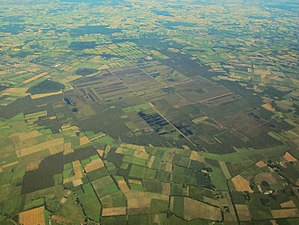Great Moor (Uchte)
|
Great bog
|
||
|
Aerial view from the southwest |
||
| location | Lower Saxony , Germany | |
| surface | 3263 ha | |
| Identifier | NSG HA 208 | |
| WDPA ID | 378372 | |
| Geographical location | 52 ° 30 ' N , 8 ° 47' E | |
|
|
||
| Sea level | from 41 m to 44 m | |
| Setup date | 01/25/2007 | |
| administration | NLWKN | |
The Great Moor (also called Uchter Moor or Great Uchter Moor ) is a 3,263 hectare high moor area near Uchte in the Nienburg / Weser district in Lower Saxony ( Germany ), which has been a nature reserve since 2007.
The moor area consists partly of near-natural areas, former peat cuttings and raised bog grassland.
geography
location
The Great Moor is located in the southwestern part of the North German Plain not far west of Uchte between Bahrenborstel (7 km away in the north), Warmsen (5 km in the south-east), Diepenau -Essern (2 km in the south-west) and Wagenfeld - Ströhen (7 km in the north-west ). A few kilometers to the west, northwest and north of the Great Moor is passed by a section of the Great Aue . Streams moving towards this river drain the moorland.
division
The Great Moor consists of these partial moors:
- Burgmoor
- Herrenmoor
- Löhmoor
history
Around 1700 BC In the north-eastern part, the Darlaten Moor, a Bronze Age moor path was created from alder and oak trunks. For centuries, peat was cut by hand in the Great Moor and used as fuel for the rural population. From the 1920s, peat mining began on a larger scale. Around 1925, the Bremen businessman Werner Most founded a peat extraction company in Uchte, which ceased production in the late 1990s. In 1931 Wintershall AG founded the peat factory union Uchte - Torfwerke am Fuchsberg near Darlaten, which is still active today. It operates a field railway in the moor, with which the excavated peat is transported away. The factory building was destroyed in a fire in 1978. Another company that is no longer active today was the Essern peat company . In 1959 a moor fire broke out in the Great Moor. Until the early 1960s, the peat was cut by hand and piled up in large heaps .
Bog track
2006 heimatkundlich and tourist oriented emerged Moor Railway light eaters . At the same time, an observation tower and information center with a café were set up. The joint municipality of Uchte had already acquired tracks from a former peat factory in 2001. The approximately 10 km long route network in the moor is the longest network of similar railways in Lower Saxony. Regular rail operations organized by the Friends' Association take place from April to October.
Bog corpse
In the years 2000 and 2005 was in the Great Moor Uchter district Darlaten at Torfstecharbeiten the bog body of the girl from the Uchter Moor found. It is the remains of a young girl who died in the pre-Roman Iron Age around 650 BC. Lived. It is the youngest bog body found in Germany and at the same time the oldest bog body from Lower Saxony.
Skeleton parts of the bog body girl from the Uchter Moor
literature
- Samtgemeinde Uchter Moor (ed.): Moormemento: Das Große Uchter Moor . Uchte 2015 (information brochure on the Uchter Moor and the moor body find).








